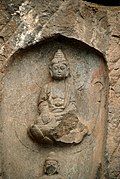Jindeng Temple
| Jindeng Temple | |
|---|---|
金灯寺 | |
 A censer at the temple. | |
| Religion | |
| Affiliation | Buddhism |
| Deity | Chan Buddhism |
| Location | |
| Location | Xingcheng Town, Changzhi, Shanxi |
| Country | China |
| Geographic coordinates | 36°01′46″N 113°41′18″E / 36.029341°N 113.688228°E |
| Architecture | |
| Style | Chinese architecture |
| Founder | Chan master Yu (芋禅师)[1] |
| Date established | Northern Qi (550–577) |
Jindeng Temple (simplified Chinese: 金灯寺; traditional Chinese: 金燈寺; pinyin: Jīndēng Sì; lit. 'Golden Light Temple') is a Buddhist temple located in Xingcheng Town of Changzhi, Shanxi, China.[2] It was built in the steep precipices and cliffs in Beiquan Village, 65-kilometre (40 mi) to the northeast of Pingshun County. The temple is renowned for its grottoes, rock and statues of Buddha.[3]
History[edit]
The original temple dates back to the 6th century, in the Northern Qi (550–577). At that time, it initially called "Baoyan Temple" (宝岩寺).[4]
In the temple there are 14 Buddhist niches, 37 Buddhist shrines, and over 500 statues of Buddha carved from 1504 to 1565.
In June 2006, it was listed among the sixth group of "Major National Historical and Cultural Sites in Shanxi" by the State Council of China.[5]
Architecture[edit]
The entire complex are all built on cliffs which are over 1,700-metre (5,600 ft) from the ground. The existing main buildings include the Hall of Water and Land (水陆殿), Hall of Grand Buddha (大佛殿), Hall of Lord Guan (关帝殿), Pavilion of Juxian (聚仙楼), and Pavilion of Ksitigarbha.[6]
Gallery[edit]
-
Halls at Jindeng Temple.
-
Grottoes.
-
Grottoes.
-
Statue of Buddha.
-
Statues of Buddha.
References[edit]
- ^ 金灯寺塔林 千佛塔最大. sina (in Chinese). 2014-12-22.
- ^ 走过晋东南金灯寺石窟(超多美图). weather.com.cn (in Chinese). 2009-09-11.
- ^ 悬崖上的千年金灯寺 山西之最. eastday.com (in Chinese). 2016-12-10.
- ^ "Grottoes of Jindeng Temple in Pingshun County". Sohu (in Chinese). 2014-10-22. Archived from the original on 2018-06-28. Retrieved 2018-06-28.
- ^ 国务院关于核定并公布第六批全国重点文物保护单位的通知. gov.cn (in Chinese). 2006-06-02.
- ^ 【山西风光】金灯寺. Sohu (in Chinese). 2017-09-02. Retrieved 2020-01-06.







